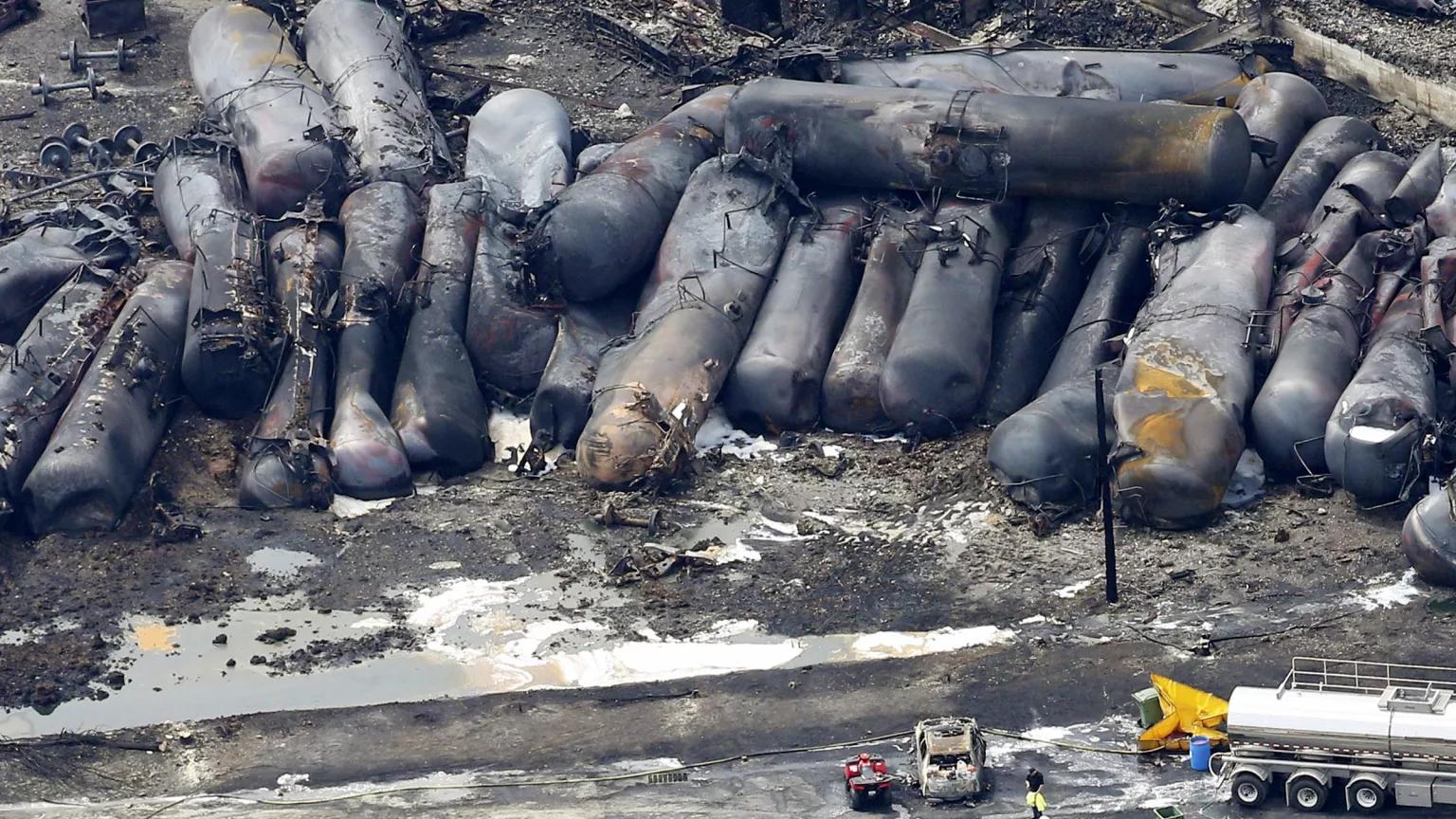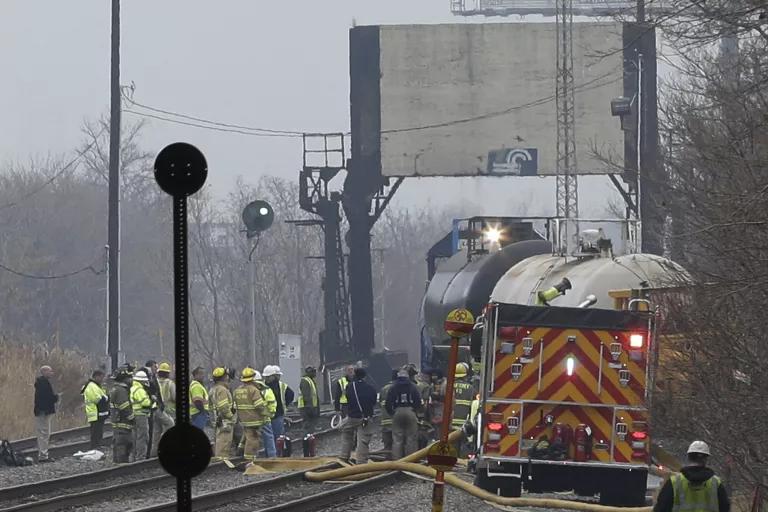These New Jerseyans Want to Bring “Bomb Trains” to a Halt
Trains carrying combustible crude oil barrel on rickety rails through the Garden State, threatening the safety of millions of people—and their drinking water—every single day.

Firefighters near the remains of a freight train explosion in Lac Mégantic, Canada in 2013. The driverless, runaway fuel train exploded, killing dozens of residents.
Mathieu Belanger/Reuters
On an early-summer morning five years ago, an unattended 74-car train carrying highly flammable crude oil from the Bakken fields of North Dakota rolled down a hill and into the small town of Lac-Mégantic, Québec. The resulting explosion, which railway workers described as apocalyptic, killed 47 people and destroyed much of the town, making the disaster one of the deadliest rail accidents in recent history.
Unfortunately, it wasn’t the last. Since 2013, other devastating accidents involving crude-carrying trains have occurred across the United States and Canada—in West Virginia, Oregon, and Ontario, to name a few places—and New Jerseyans fear one of their communities could be the next to suffer from a “bomb train” disaster.
“I’d never paid attention to the trains, which pass a couple blocks from my house,” says Teaneck resident Paula Rogovin. “I’d see them, but you don’t really think about something until you need to.”
After learning about the dangers of crude-by-rail and the growing frequency with which the trains were traveling through her neighborhood—adjacent to schools, daycare and senior centers, and, critically, the drinking-water supply for roughly a million people—Rogovin decided to do something about it. A lifelong activist, she organized a protest against the threat the oil trains posed to her community. Only six people attended that initial rally in August 2014, which took place next to the CSX tracks that run past a park and ball field in Teaneck. But Rogovin and her fellow advocates weren’t discouraged. They continued to spread the word about the trains to their neighbors and scheduled a second rally three months later. This time, more than 50 people turned up.
The interest in the issue inspired Rogovin to keep pushing for greater awareness of the threats faced by the seven New Jersey counties through which ran the CSX River Line, the rail line that the oil trains barreled along. In 2015 she founded the Coalition to Ban Unsafe Oil Trains, and the group began lobbying state lawmakers to implement policies that would hold train owners accountable for the safety of their operations.
Dangerous Freight
“In the beginning we thought we just needed safer tank cars,” Rogovin says. “We soon learned that the cars really weren’t the problem.” In fact, one of the biggest problems is the oil itself. Bakken crude has earned a reputation for being extremely combustible, due to its high concentration of volatile gases like propone, butane, and ethane released by the fracking process.
When the oil is transported by train—in chains of up to 120 cars that stretch a mile long—it’s like shaking these explosive chemicals in a tin can, distilling the oil from the gases and increasing what’s known as vapor pressure, explains Kimberly Ong, an NRDC staff attorney who focuses on Northeast regional issues. Ong is working alongside other environmental and community groups to advocate for federal safeguards for crude-by-rail trains—including limits on vapor pressure, which can be controlled by existing technologies. Because of legal loopholes, there is currently no cap on the cargo flammability of these trains, which pass near the homes of some 25 million Americans. A collision or derailment could result in the train cars exploding in a chain reaction, with one igniting after the other, explains Ong. What’s more, there are few measures in place to minimize the potential damage. Most fire departments in New Jersey (and other states through which these trains run) aren’t equipped to control such disasters, so the fires can last for days and require the evacuation of entire communities.

Emergency workers at the site where a freight train derailed, in Carteret, N.J. in 2013
Julio Cortez/Associated Press
And this problem is becoming more prevalent. As fracking in North Dakota has boomed, so has the number of crude-oil trains crisscrossing the country. According to the Association of American Railroads, between 2008 and 2014 crude-by-rail traffic jumped from 9,500 to more than 490,000 carloads per year, an increase of more than 5,000 percent. In 2014, oil train spills also hit a record high of 141 incidents yielding “unintentional releases,” according to reports from the federal Pipeline and Hazardous Materials Safety Administration. (Between 1975 and 2012, an average of 25 spills took place each year on U.S. railroads.) The numbers attest to the ever-present dangers associated with the practice of transporting crude by rail, says Ong, who adds, “Even if the federal government were to place limits on oil volatility in trains, it is still unclear whether we can ever make oil trains truly safe.”
Up to several dozen bomb trains pass through New Jersey every week, first arriving in Albany, New York, from the west, then turning south on their journey to an oil refinery in Philadelphia. Along the way, they slice through the heart of the Hackensack River watershed, traveling near or over four reservoirs, then traversing 8,500 acres of wetlands and wildlife habitat in the lower part of the watershed. And once they get to Newark, New Jersey, the freight tracks run parallel to the Northeast Corridor, the busiest passenger rail line in the United States.
Rallying for Change
From his boat, Captain Hugh Carola of Hackensack Riverkeeper (a member of the Coalition to Ban Unsafe Oil Trains) has witnessed the state of utter disrepair of portions of the local freight lines. “These trains cross some ridiculously rusted and cracked bridges in Bergen, Hudson, and Essex Counties,” he says. Though Carola and other members of the coalition continue to strive toward its namesake goal (a total ban), they are currently focused on more easily achievable interim steps. “If we can’t stop these trains,” he says, “we want to at least ensure that the first responders know when they’re coming through and that every rail and bridge is inspected.”
The coalition is pressing for action on a proposed oil train transparency bill that would require railroads to develop a response plan for potential spills. The New Jersey state legislature passed the bill last year, but then-Governor Chris Christie, pressured by CSX, vetoed it. In March, however, under the state’s new, more environmentally conscious governor, Phil Murphy, senate majority leader Loretta Weinberg reintroduced the bill, hoping to see it signed into law.
Because hopes of gaining stronger federal crude-by-rail regulations have been stymied by the Trump administration, such local and state efforts are critical. The Coalition to Ban Unsafe Oil Trains continues to organize demonstrations, hold monthly meetings, and spread the word to neighbors. It’s also taken up another important cause: stopping the construction of a new fracked-gas power plant slated for New Jersey’s Meadowlands, meant to supply electricity to New York City.
“The key is to protect the water, protect the people, protect the community—now,” Carola emphasizes. “We need both long-term and short-term goals, and right now we’re working the short term. I don’t see anything positive long-term with this administration. We’ll do what we can at the state level.”
Rogovin, who just retired after 44 years as a schoolteacher, has no plans to give up her activism. “It’s frustrating when you fight the good fight and then you see it get turned around by Trump and company. But we continue to fight anyway, because we have to.”
This NRDC.org story is available for online republication by news media outlets or nonprofits under these conditions: The writer(s) must be credited with a byline; you must note prominently that the story was originally published by NRDC.org and link to the original; the story cannot be edited (beyond simple things such as grammar); you can’t resell the story in any form or grant republishing rights to other outlets; you can’t republish our material wholesale or automatically—you need to select stories individually; you can’t republish the photos or graphics on our site without specific permission; you should drop us a note to let us know when you’ve used one of our stories.


Gibbstown LNG Terminal: A Catastrophe Waiting to Happen
Protect Your Community from “Bomb Trains”
We Could Do a Lot More to Regulate Fracking